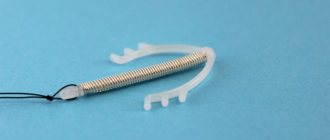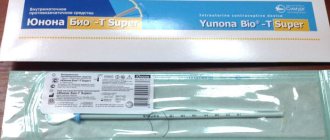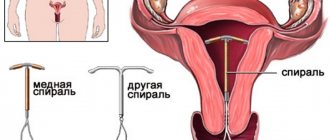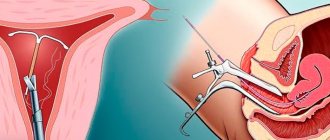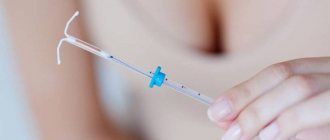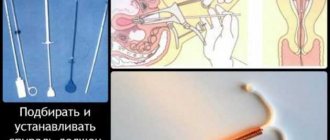Intrauterine contraceptives with propolis, in particular the IUD Juno Bio-T Super, were created to reduce the risk of early inflammatory complications after insertion of the IUD. Even strict adherence to sanitation rules when inserting an IUD does not exclude the possibility of microbes entering the uterus. The sterility of a woman’s internal genital organs is restored after 30-40 days, and all this time there is a threat of inflammation. Propolis has an antimicrobial and anti-inflammatory effect, helping the body restore its lost balance.
General information
The IUD is based on a hormonal agent, but this component may be absent. Then the spiral is supplemented with other substances (copper, silver, propolis). Any IUD has a plastic base and a copper rod. Other metals and substances are sprayed onto it.
The action of the spiral is based on creating an obstacle to the entry of sperm into the uterine cavity. The second mechanism is the formation of nonspecific inflammation, due to which the fertilized egg cannot take root in the mucous membrane of the organ. This process is also accompanied by a change in the vaginal environment to acidic, which causes sperm to die.
The effectiveness of the drug is 98% ; it is recommended to be prescribed to girls after childbirth. The spiral is most popular among women living in rural areas, mothers of many children and women over 30 years old. Some experts allow the introduction of a contraceptive to nulliparous representatives of the fairer sex, but a thorough examination is necessary to determine the presence of an inflammatory process.
Any IUD consists of several parts: a frame, a metal spiral wound on a base, and a nylon thread. The frame includes legs and hangers (or antennae), the thread at the bottom of the base is designed to remove the device.
The service life of the product depends on the composition: copper - about 5 years , silver - up to 7 . The IUD is popular because no additional manipulation is required after insertion.
Action of VMK
Intrauterine contraceptives are a means of preventing conception using special medicinal devices, small in size (from 18 to 25 mm) in the form of a spiral, ring, T or V-shaped model, installed directly in the uterine area. All IUDs are divided according to content and filling:
Inert – do not contain active components (plastic Lipps loop). In modern gynecological practice, the drug is practically not used. Bioactive - made from organic metal, resistant to oxidation and plastic. Inserts made of silver, copper, gold, and hormones are added to the main parts.
Chemical substances interfere with the progress of sperm and eggs, destroy the embryo formed after their fusion, preventing it from gaining a foothold in the uterus. Progesterone, which is among the main components, has a positive effect on the reproductive system: it reduces blood loss and pain during menstruation, and protects against cancer problems.
The spiral is selected strictly after consultation with a gynecologist, a visual examination on a chair, smears for flora and oncocytology, and sonography of the reproductive organs. The drug is selected individually according to size, components, in accordance with the structure of the internal reproductive organs.
Method of influence:
- An installed IUD releases chemicals or artificial hormones that create a barrier that is dangerous for sperm and eggs.
- The microenvironment of the genitals is oxidized, slowing down the movement of the male seed. Metal particles increase the contractile activity of the uterus, preventing the resulting embryo from settling inside it. The result of exposure is a mini-abortion, in which the embryo leaves the woman’s body with monthly bleeding.
- Under the influence of copper, silver, gold, incomplete maturation of the egg occurs, the fertilization of which at the time of passage through the pipes is impossible.
- When an IUD with progesterone is inserted, the body, under the influence of the hormone, begins to feel pregnant. The ovaries stop producing eggs. Ovulation does not occur.
Characteristics of Juno spiral types
Varieties of products are due to the fact that they have different shapes and compositions. There is a Juno Bio-T spiral with silver or copper , propolis , F-configuration with similar components, ring-shaped .
The first option consists of a plastic base and a copper-silver thread. The T-shape is suitable for women with small organ sizes. Due to the structural features, perforation of the uterus may occur.
The copper type of spiral Juno Bio-T has the lowest price and is set for five years. In appearance it resembles an anchor. Another version of a similar form with propolis has the prefix Super . It is a little more expensive, but coating with a medicinal composition helps protect the mucous membrane from inflammation. Silver plating of the copper winding of the Juno Bio-T Ag protects the metal from oxidation, as a result of which it lasts two years longer.
What is involved in installing a copper helix?
For a woman, the procedure for inserting a copper IUD is similar to a routine gynecological examination.
Before installing the IUD, the doctor performs a routine gynecological examination. This is necessary to determine the position and structural features of the pelvic organs and to exclude diseases that may increase the likelihood of complications during or after installation of the IUD - in particular, cervical infection or pelvic inflammatory disease.
Next, the doctor fixes the cervix with a special instrument, inserts a sterile probe into the cervical canal and advances it into the uterine cavity. This makes sure that the cervical canal is patent and gives the doctor an accurate idea of the size of the uterine cavity.
After this, the doctor removes the probe and, using a plastic applicator, inserts a coiled spiral into the uterine cavity.
After installation, the threads attached to the lower end of the spiral are cut a few centimeters below the entrance to the cervix.
More than half of women who undergo this procedure report that insertion of the IUD was completely painless or almost painless. The remaining women rate the insertion of the IUD as “painful” or “unpleasant.”
Pain in the lower abdomen may persist for several days after insertion of the IUD.
Simple painkillers (such as paracetamol or ibuprofen) can be used to relieve pain.
Installing a spiral is a relatively safe procedure. Any serious complications during or after installation of the IUD rarely develop (see below).
***
Loss of the IUD from the uterine cavity into the vagina (or out) is observed, on average, in 2-10% of women, and most often occurs during the first 3 months after its installation.
In women who took part in one study, the average probability of a copper wire coil (with a copper surface area of 200 sq.mm) falling out over 5 years was 6.7%.
The likelihood of the IUD falling out is higher in women who experienced heavy menstrual bleeding, severe pain during menstruation, or the presence of uterine fibroids before inserting the IUD. In women with submucous fibroids, the chance of the IUD falling out may be up to 12% (see also Uterine Fibroids, a comprehensive guide for women).
The likelihood of prolapse is also slightly higher in younger women, in women with an abnormally shaped uterus, and in women who have experienced IUD prolapse in the past.
The risk of IUD prolapse does not depend on the length of the uterus, whether a woman has given birth in the past or not, or whether she uses vaginal tampons.
Instructions for use
There are the following terms for placing a contraceptive:
- immediately after termination of pregnancy;
- period 4-19 days of the cycle;
- after removing the old device;
- after 3-4 days as an emergency contraceptive;
- 6-8 weeks after birth.
Installing a spiral involves following several sequential steps. It is necessary to undergo an examination to exclude the presence of contraindications. In a healthy woman, if installed correctly, the likelihood of adverse reactions and complications is minimal.
The survey includes several points:
- Ultrasound of the pelvic organs;
- colposcopy;
- smear on flora.
If everything is in order, then the steps for installing the spiral are as follows:
- Measuring the length of the cavity.
- Dilatation of the cervix in the speculum.
- Treatment with an antiseptic solution and grasping with forceps.
- Placement of the IUD with a probe.
- Correction of the length of the lateral antennae.
Since manipulation is an intervention, the doctor prescribes a course of broad-spectrum antibiotics to prevent infection in the cavity.
Reviews from women about the intrauterine system "Junona Bio-T"↑
Ladies who are suitable for the intrauterine method of contraception are satisfied with the high effectiveness of the product, its low cost, long period of use and the fact that side effects occur in rare cases. It is noted that during sexual intercourse the “antennae” of the spiral is not felt by the partner.
The disadvantages of using the device include the mechanism of action of the spiral, heavy periods, a possible metallic smell and an unpleasant procedure for installing the product. Some women associate the appearance of cervical erosion with this method.
Advantages and disadvantages
Each contraceptive method has positive and negative sides. The advantages of using a spiral are:
- no monthly costs;
- high degree of efficiency;
- ease of use;
- low cost;
- inability to influence ovulation.
The following list may serve as a fly in the ointment:
- the IUD does not protect against ectopic pregnancy;
- the likelihood of dangerous complications;
- does not protect against STIs;
- can grow into a woman’s internal organ;
- pain during menstruation increases;
- a wide list of contraindications;
- there is still a possibility of pregnancy.
All a woman needs to do is buy the right product at the pharmacy and make an appointment with a gynecologist. When the IUD is installed correctly, it receives almost complete protection against unwanted pregnancy. If a woman has a regular sexual partner, then she is not afraid of infections transmitted through contact. There is no need to think about taking pills at the same time or using a condom. Sexual intercourse feels no different from normal.
5-7 years is a long time, so it is necessary to periodically check whether the IUD is positioned correctly in the uterus. This is the prevention of pregnancy development, as well as complications. For some women, the main reason for not using the IUD is considered to be pain during menstruation. If you do not check for restrictions before introducing the product, the consequences can be disastrous.
Disadvantages of using a spiral ↑
Key factors to consider before starting to use this method of contraception
- Before administration, a thorough examination by a gynecologist and a series of tests are required.
- The product can only be administered and removed by a doctor in a clinic or gynecological office at a antenatal clinic.
- Periods may become painful, prolonged and heavy.
- It is necessary to check the “antennae” of the spiral after each menstruation, especially if it was accompanied by severe pain.
- The system may fall out of the uterine cavity on its own.
- Any of the sexually transmitted infections in the presence of an intrauterine contraceptive is difficult and with complications.
- There are known cases of ectopic pregnancy when using the IUD.
- Not recommended for use by nulliparous women.
- Does not protect against sexually transmitted diseases.
Contraindications
The list of conditions in which a woman needs to find another option for contraception can be presented as the following list:
- deviation from the classical shape of the organ;
- established or suspected pregnancy;
- tumor of any nature;
- bleeding;
- copper intolerance;
- AIDS;
- inflammation of the upper genital tract.
There are relative contraindications when the use of an IUD is undesirable, but possible. These are hematological disorders, endometriosis, young and old age, chronic pathologies of the excretory system.
When using the IUD, the likelihood of an ectopic pregnancy increases. Therefore, if a woman has had such experience in the past, then it is necessary to weigh all the factors.
Who is the Juno Bio-T intrauterine device contraindicated for?↑
There are certain contraindications in which using the product is dangerous to health.
- The presence of sexually transmitted diseases currently or in the last three months.
- Complicated abortion.
- Abnormal structure of the uterus or the presence of benign neoplasms that deform the uterine cavity.
- Pelvic tuberculosis and genital cancer.
- Lack of a regular sexual partner.
- Uterine bleeding of unknown cause.
Side effects and possible complications
The following undesirable effects that appeared after the introduction of the spiral may be associated with a poor examination before the procedure, the peculiarities of its action, or incorrectly performed manipulation:
- ectopic pregnancy;
- pain during menstruation;
- device falling out;
- increased blood volume during menstruation;
- decreased libido;
- inflammation of the uterus, tubes, ovaries;
- pregnancy.
In addition to these conditions, unpleasant complications associated with a foreign body appear:
- ingrowth of the IUD into the thickness of the mucous membrane;
- perforation of the uterus;
- loop falling out.
Introduction
The copper intrauterine device (copper IUD) creates a very high, stable and long-lasting contraceptive effect.
To maintain the contraceptive effect of the IUD, after its introduction, no action is required on the part of the woman. The effect lasts for 3-10 years, depending on the brand of the device.
The copper intrauterine device has one of the highest safety profiles (compared to other contraceptives). Thanks to this, almost all women of any age can use it.
The copper IUD can also be used as an emergency contraceptive if a woman seeks insertion of the IUD within 7 days of unprotected sex (see also Emergency contraception: More information for women).
This article is an addition to the Guide to Contraception and Contraception, which provided information regarding the use of the copper IUD as a contraceptive and its comparison with other contraceptives.
Women who, based on the recommendations presented in the guide above, have concluded that a copper IUD may be a suitable solution for them will then find evidence-based answers to the following questions:
- What is known about the possible negative and positive effects that the copper IUD can have on various aspects of a woman's health in the short and long term? Specifically, what complications and side effects may be associated with insertion, wearing, and removal of a copper IUD, and what can be done to eliminate or alleviate these side effects?
- What recommendations should women follow to ensure maximum effectiveness and safety of wearing a copper IUD?
- before starting to use this product;
- during the period of use of this product.
***
In addition to copper intrauterine devices, there is another type of IUD - an intrauterine device with levonorgestrel. This type of IUD is different from copper IUDs. Answers to questions related to their use are presented in a separate article: Intrauterine device with levonorgestrel. Information for women.
Reviews
An intrauterine device, chosen correctly, evokes only positive emotions in girls:
After giving birth, the issue of contraception arose. Before pregnancy I used OK, but now I don’t want hormones to affect the child. The doctor suggested introducing a Juno coil. Now I don't have to worry about remembering to take my pill. I don’t feel any unpleasant sensations, I’m very pleased.
Yulia A.
I have three children. My last pregnancy was unplanned due to a bad experience using a condom. Therefore, I decided to take responsibility for protection and installed a silver-coated spiral. After this, menstruation became a little heavier and more painful, but the benefits of the IUD cannot be compared with such a trifle. Very convenient, reliable, and no inconvenience.
Tatiana V.
Analogs
The Juno spiral is not the only possible option for a non-hormonal contraceptive. Its analogues are the following models:
- Nova-T Cu Ag;
- Multiload;
- Gravigard – Cu-7.
They have different shapes, materials and manufacturers, so they differ in target audience, period of use, and also have application features. The doctor can recommend one type or another, based on experience of use, as well as on the financial capabilities of the lady.


